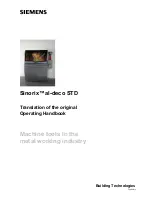
ENGLISH
11
11
This manual is consistent with the date of manufacture of
your machine, you will find information on the technical
data of the machine acquired manual check for updates of
our machines on the website:
www.grupostayer.com
The machine is intended for dry sanding and polishing of
wood, plastic, metal, filler, as well as for painted surfaces.
It is especially suitable for profiles, corners or hard to
reach locations. Please refer to the booklet included in
delivery for the safety instructions.
1.
Machine-specific Safety Warnings
Use the machine only for dry sanding.
Penetration of
water into the machine increases the risk of an electric
shock.
Caution, fire hazard! Avoid overheating the object
being sanded as well as the sander. Always empty the
dust collector before taking breaks.
In unfavourable conditions, e. g., when sparks emit from
sanding metals, sanding debris in the dust bag, micro filter
or paper sack (or in the filter sack or filter of the vacuum
cleaner) can self-ignite.
Particularly when mixed with remainders of varnish,
polyurethane or other chemical materials and when the
sanding debris is hot after long periods of working.
Secure the workpiece.
A workpiece clamped with
clamping devices or in a vice is held more secure than
by hand.
Keep your workplace clean.
Blends of materials are
particularly dangerous. Dust from light alloys can burn or
explode.
Never use the machine with a damaged cable. Do not
touch the damaged cable and pull the mains plug
when the cable is damaged while working.
Damaged
cables increase the risk of an electric shock
The male connection plug must only be connected to a
female plug with the same technical characteristics as the
corresponding male plug.
2. Instrucciones de puesta en servicio
2.1 Montaje de platos
Colocación del papel abrasivo:
CAUTION::
Always be sure that the tool is switched off and unplugged
before installing or removing the paper.
Model (Fig. 1 and 2).
Raise the lever. Insert the paper end into the clamper, alig
-
ning the paper edges even and parallel with the sides of
the base.
(Prebending the paper makes attachment easier). Once
the paper is in place, return the lever to its original po-
sition. Repeat the same process for the other end of the
base, maintaining the proper paper tension.
CAUTION:
After inserting the paper, make sure the teeth of the clam-
per hold it securely. Otherwise the paper will be loose and
subject to slippage, resulting in uneven sanding operation.
Para colocar el papel de lija:
1. Set the tool upside down so that the pad is on top.
2. Position the sandpaper to fit the shape of the base. Be
sure to align the holes on the sandpaper with the holes
on the pad (the dust will be sucked into these holes; it is
therefore important to leave them open).
3. Press the paper firmly over the pad.
Note:
If the sandpaper is in good condition, save it for
further use.
When sanding in narrow, hard-to-reach areas (e.g., shu
-
tters, blinds, louvres), attach the cone-shaped abrasive
papers to the end of the pad (bottom and top). To sand the
end of thin materials, fold the abrasive paper and attach to
the side of the pad as shown in Fig. 4 and 5.
To remove the sandpaper:
1. Set the tool upside down so that the sandpaper is on
top.
2. Grasping one corner of the sandpaper, peel it from the
pad.
Plates assembly (fig. 2 ):
Loosen and remove the 6 screws located on the rubber
base, remove it to place any of the dishes.
Please note that each chainring must be fastened with the
appropriate screws and supplied from the factory.
Rectangular plate is fastened with 4 round head screws
11 and the “V” plate is fastened with 4 countersunk screws
12. Otherwise uneven sanding may occur.
2.2 Electric connection
The tool must only connect to one source
power supply of the same voltage as indicated in the
nameplate, and can only operate on single-phase alterna-
ting current. The tool’s double insulation system complies
with the European standard and can therefore also be
used in sockets without a ground conductor.
2.3 Technical Features
1) Front paper fixing clip.
2) Rear paper fixing clip.
3) Grip.
4) Abrasive paper (sandpaper).
5) Rectangular plate.
6) “V” plate.
7) Plate.
8) Rubber base.
9) Ventilation holes.










































